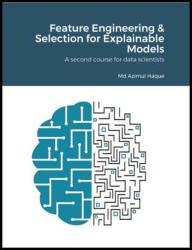Feature Engineering & Selection for Explainable Models : A Second Course for Data Scientists
- Добавил: literator
- Дата: 29-12-2022, 04:58
- Комментариев: 0
 Название: Feature Engineering & Selection for Explainable Models: A Second Course for Data Scientists
Название: Feature Engineering & Selection for Explainable Models: A Second Course for Data ScientistsАвтор: Md Azimul Haque
Издательство: Leanpub
Год: 2022-12-28
Страниц: 196
Язык: английский
Формат: pdf (true)
Размер: 10.2 MB
Learn about the 10 percent of things that make 90 percent of impact in your Machine Learning projects.
In this book, I have tried to address the most common issues that can change the outcome of a Machine Learning project: feature engineering, feature selection, and model explanation. The interplay between these 3 methods.
I have been teaching Data Science as a part-time faculty and have taught hundreds of students. Many of my students have successfully transitioned to a Data Science career. I also have a set of open-source contributions as Python libraries. I often get requests from my previous students when they start working on their first real Machine Learning project. I found the root cause of many challenges faced by my students who recently transitioned into Data Science and Machine Learning. I have tried to address these issues in my book and would like to dedicate this book to all my students for all the love and respect I have received.
There are many methods for feature engineering, feature selection and signal processing which were not available previously in Python. I have coded and open-sourced these methods as Python libraries over the years. Often, I get approached by researchers who use my Python libraries, for understanding how to use certain algorithms and best practices for these algorithms. I have tried to explain these with the aid of underlying theory, and visualizations in this book.
This book aims to be a second course for beginner Machine Learning engineers who use Python. It aims to answer the question "What to do now?" challenge faced by machine learning engineers and researchers when they are stuck below than desired model performance and are looking for ways to improve model performance. The ideal audience for the book is those who did a course on Data Science/Machine Learning, researchers who are exploring traditional Machine Learning algorithms for their thesis, people who are working in their first job as a data scientist, people with 1-3 years of experience in Data Science, and leaders who transitioned to lead data science team but do not have the background and want to speak with the technical team with confidence. Experienced, seasoned, and veteran data scientists and researchers who want to try new feature engineering, feature selection, and signal processing techniques, as well as to look at existing techniques with a fresh perspective. Supplemental code is provided in the accompanying GitHub page for the book to understand how all the analysis was done. This book is neither mathematical notation heavy nor code heavy. We have instead tried to explain the theoretical nuances, and in some cases aided the explanation with plots and analysis results. This is to give a feel of hand-held projects from beginning to completion.
The objective of the book is to make the readers self-sufficient in the fine art of developing highly accurate Machine Learning models that make it to production. We will cover different stages of the Machine Learning project from development to the explanation of model predictions. Learning the fundamental building blocks of building machine learning models will make us better educated machine learning engineers, researchers, capable consultants, and confident leaders. This book will help beginners shorten their learning curve in their journey to become capable machine learning engineers. For experienced consultants, we cover some methods and techniques which are less often heard and used. Techniques that were not available in Python previously. For leaders in Data Science, it will help you get perspective on how to advocate your models by using model explainability.
We assume that the readers are aware of what is regression, and what is classification. Different Machine Learning techniques generally used. For example, linear regression, random forest, logistic regression, etc. Different cost functions, such as root mean square error (RMSE), F1 score, Precision, and Recall. The reader has tried their hands at developing models and needs help in improving model performance from the existing level to a higher level.
Although concepts covered in the book are applicable across programming languages, this book is written for Python users. It is for the same purpose that several algorithms mentioned in this book were developed from scratch and open-sourced as 4 separate Python libraries by the author. It is assumed that the reader has a basic understanding of libraries such as Sklearn for Machine Learning, Pandas, and Numpy for data manipulation, as well as Matplotlib and Seaborn for data visualization.
Скачать Feature Engineering & Selection for Explainable Models : A Second Course for Data Scientists
Внимание
Уважаемый посетитель, Вы зашли на сайт как незарегистрированный пользователь.
Мы рекомендуем Вам зарегистрироваться либо войти на сайт под своим именем.
Уважаемый посетитель, Вы зашли на сайт как незарегистрированный пользователь.
Мы рекомендуем Вам зарегистрироваться либо войти на сайт под своим именем.
Информация
Посетители, находящиеся в группе Гости, не могут оставлять комментарии к данной публикации.
Посетители, находящиеся в группе Гости, не могут оставлять комментарии к данной публикации.
